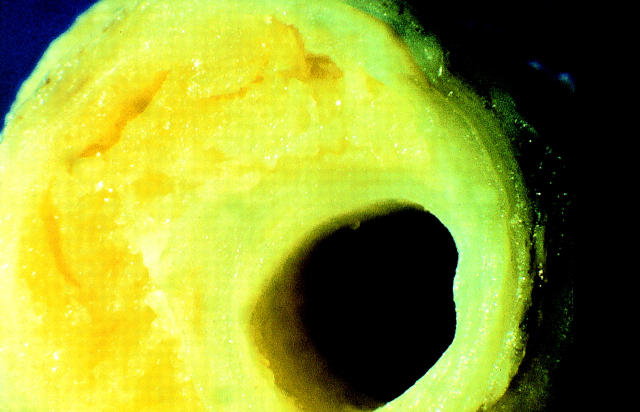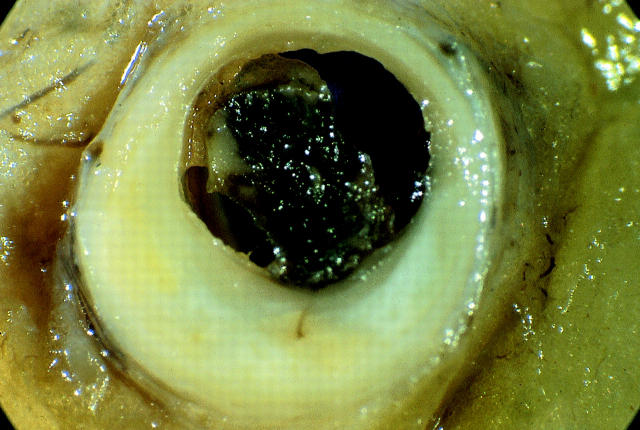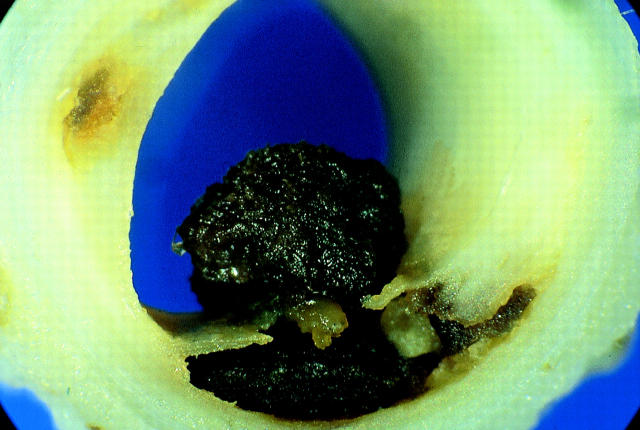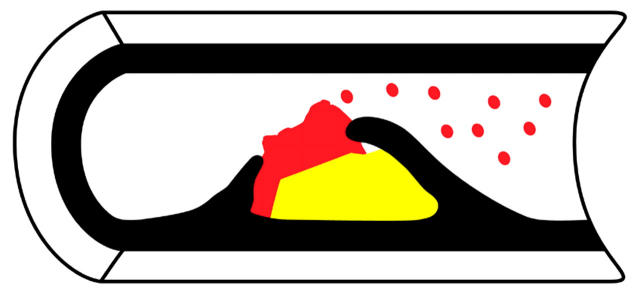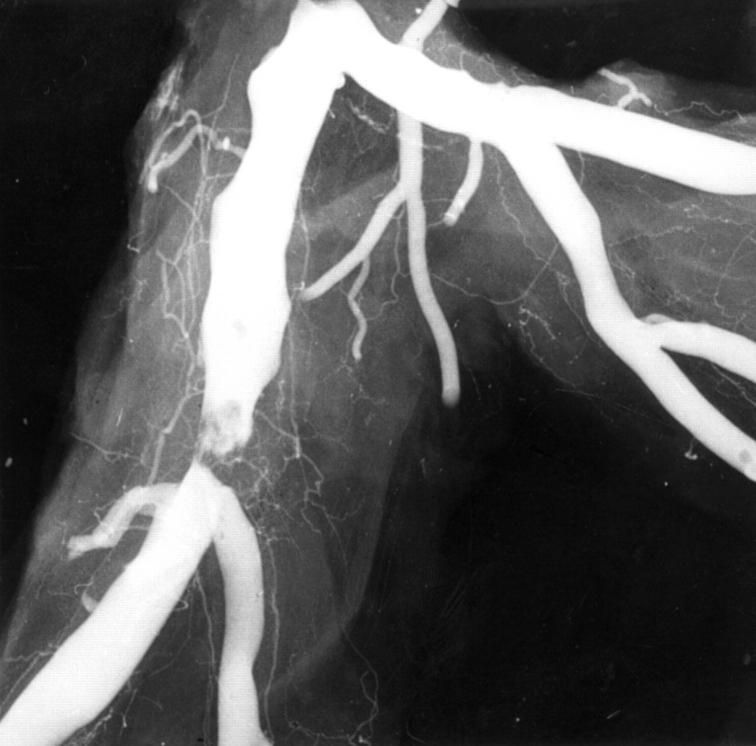Full Text
The Full Text of this article is available as a PDF (185.5 KB).
Figure 1: .
The established stable plaque. In this cross section of a human coronary artery there is an established fibrolipid plaque with a core of lipid. The lipid core is separated from the lumen by the plaque cap. The plaque only occupies part of the circumference of the artery, leaving a segment of normal arterial wall.
Figure 2: .
Thrombosis caused by erosion. This human coronary artery is largely occluded by a mass of thrombus which is adherent to the surface of a plaque. The plaque itself is intact.
Figure 3: .
Thrombosis caused by disruption. The cap of a plaque has torn and projects up into the lumen. Thrombus has formed within the original lipid core from where it projects into, but does not totally occlude, the lumen. This is the typical lesion of unstable angina.
Figure 4: .
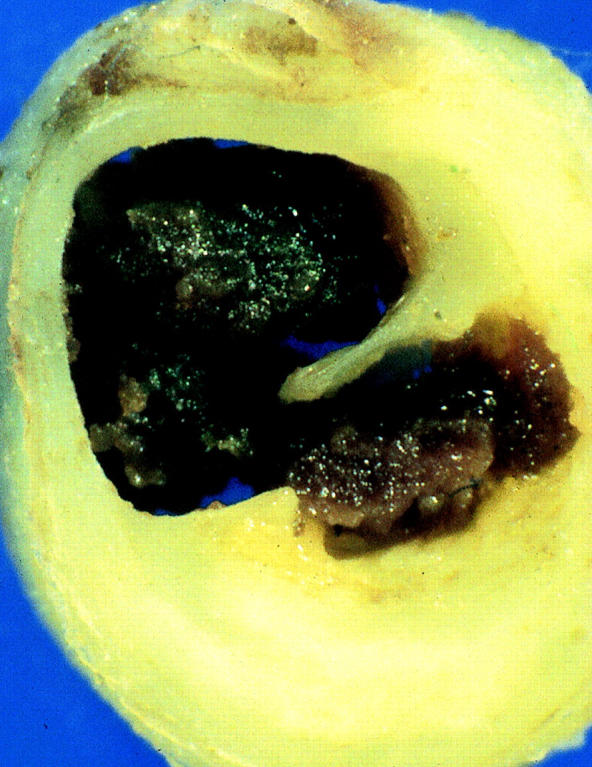
Thrombosis caused by disruption. The cap of the plaque has torn and thrombus within the lipid core extends into and occludes the lumen. This is the typical lesion of acute myocardial infarction.
Figure 5: .
Platelet embolisation. Any thrombus (red) which protrudes into the arterial lumen but does not occlude has the surface covered by a layer of activated platelets strongly expressing the IIb/IIIa receptor. Clumps of these platelets are swept down into the myocardium vascular bed.
Figure 6: .
Angiogram of plaque disruption. In this postmortem angiogram there is a typical type II eccentric ragged stenosis with an overlying intraluminal filling defect indicating thrombus over the plaque.
Selected References
These references are in PubMed. This may not be the complete list of references from this article.
- Aikawa M., Voglic S. J., Sugiyama S., Rabkin E., Taubman M. B., Fallon J. T., Libby P. Dietary lipid lowering reduces tissue factor expression in rabbit atheroma. Circulation. 1999 Sep 14;100(11):1215–1222. doi: 10.1161/01.cir.100.11.1215. [DOI] [PubMed] [Google Scholar]
- Ambrose J. A., Winters S. L., Stern A., Eng A., Teichholz L. E., Gorlin R., Fuster V. Angiographic morphology and the pathogenesis of unstable angina pectoris. J Am Coll Cardiol. 1985 Mar;5(3):609–616. doi: 10.1016/s0735-1097(85)80384-3. [DOI] [PubMed] [Google Scholar]
- Arbustini E., Dal Bello B., Morbini P., Burke A. P., Bocciarelli M., Specchia G., Virmani R. Plaque erosion is a major substrate for coronary thrombosis in acute myocardial infarction. Heart. 1999 Sep;82(3):269–272. doi: 10.1136/hrt.82.3.269. [DOI] [PMC free article] [PubMed] [Google Scholar]
- Braunwald E. Unstable angina: an etiologic approach to management. Circulation. 1998 Nov 24;98(21):2219–2222. doi: 10.1161/01.cir.98.21.2219. [DOI] [PubMed] [Google Scholar]
- Burke A. P., Farb A., Malcom G. T., Liang Y. H., Smialek J., Virmani R. Coronary risk factors and plaque morphology in men with coronary disease who died suddenly. N Engl J Med. 1997 May 1;336(18):1276–1282. doi: 10.1056/NEJM199705013361802. [DOI] [PubMed] [Google Scholar]
- Chen L., Chester M. R., Redwood S., Huang J., Leatham E., Kaski J. C. Angiographic stenosis progression and coronary events in patients with 'stabilized' unstable angina. Circulation. 1995 May 1;91(9):2319–2324. doi: 10.1161/01.cir.91.9.2319. [DOI] [PubMed] [Google Scholar]
- Davies M. J. Stability and instability: two faces of coronary atherosclerosis. The Paul Dudley White Lecture 1995. Circulation. 1996 Oct 15;94(8):2013–2020. doi: 10.1161/01.cir.94.8.2013. [DOI] [PubMed] [Google Scholar]
- Davies M. J. The composition of coronary-artery plaques. N Engl J Med. 1997 May 1;336(18):1312–1314. doi: 10.1056/NEJM199705013361809. [DOI] [PubMed] [Google Scholar]
- Davies M. J., Thomas A. C., Knapman P. A., Hangartner J. R. Intramyocardial platelet aggregation in patients with unstable angina suffering sudden ischemic cardiac death. Circulation. 1986 Mar;73(3):418–427. doi: 10.1161/01.cir.73.3.418. [DOI] [PubMed] [Google Scholar]
- Davies M. J., Woolf N., Rowles P. M., Pepper J. Morphology of the endothelium over atherosclerotic plaques in human coronary arteries. Br Heart J. 1988 Dec;60(6):459–464. doi: 10.1136/hrt.60.6.459. [DOI] [PMC free article] [PubMed] [Google Scholar]
- Falk E. Unstable angina with fatal outcome: dynamic coronary thrombosis leading to infarction and/or sudden death. Autopsy evidence of recurrent mural thrombosis with peripheral embolization culminating in total vascular occlusion. Circulation. 1985 Apr;71(4):699–708. doi: 10.1161/01.cir.71.4.699. [DOI] [PubMed] [Google Scholar]
- Glagov S., Weisenberg E., Zarins C. K., Stankunavicius R., Kolettis G. J. Compensatory enlargement of human atherosclerotic coronary arteries. N Engl J Med. 1987 May 28;316(22):1371–1375. doi: 10.1056/NEJM198705283162204. [DOI] [PubMed] [Google Scholar]
- Libby P., Egan D., Skarlatos S. Roles of infectious agents in atherosclerosis and restenosis: an assessment of the evidence and need for future research. Circulation. 1997 Dec 2;96(11):4095–4103. doi: 10.1161/01.cir.96.11.4095. [DOI] [PubMed] [Google Scholar]
- Libby P., Ridker P. M. Novel inflammatory markers of coronary risk: theory versus practice. Circulation. 1999 Sep 14;100(11):1148–1150. doi: 10.1161/01.cir.100.11.1148. [DOI] [PubMed] [Google Scholar]
- Mann J. M., Kaski J. C., Pereira W. I., Arie S., Ramires J. A., Pileggi F. Histological patterns of atherosclerotic plaques in unstable angina patients vary according to clinical presentation. Heart. 1998 Jul;80(1):19–22. doi: 10.1136/hrt.80.1.19. [DOI] [PMC free article] [PubMed] [Google Scholar]
- Ridker P. M., Cushman M., Stampfer M. J., Tracy R. P., Hennekens C. H. Inflammation, aspirin, and the risk of cardiovascular disease in apparently healthy men. N Engl J Med. 1997 Apr 3;336(14):973–979. doi: 10.1056/NEJM199704033361401. [DOI] [PubMed] [Google Scholar]
- Ross R. Atherosclerosis--an inflammatory disease. N Engl J Med. 1999 Jan 14;340(2):115–126. doi: 10.1056/NEJM199901143400207. [DOI] [PubMed] [Google Scholar]
- Stary H. C., Chandler A. B., Dinsmore R. E., Fuster V., Glagov S., Insull W., Jr, Rosenfeld M. E., Schwartz C. J., Wagner W. D., Wissler R. W. A definition of advanced types of atherosclerotic lesions and a histological classification of atherosclerosis. A report from the Committee on Vascular Lesions of the Council on Arteriosclerosis, American Heart Association. Circulation. 1995 Sep 1;92(5):1355–1374. doi: 10.1161/01.cir.92.5.1355. [DOI] [PubMed] [Google Scholar]
- Witztum J. L. The oxidation hypothesis of atherosclerosis. Lancet. 1994 Sep 17;344(8925):793–795. doi: 10.1016/s0140-6736(94)92346-9. [DOI] [PubMed] [Google Scholar]



